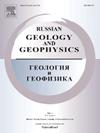Bouvet羽流:参数、演化及其与南大西洋洋中脊三联结的相互作用
IF 1
4区 地球科学
Q3 GEOSCIENCES, MULTIDISCIPLINARY
引用次数: 0
摘要
在布维岛地区(南大西洋),一个热点在洋中脊的三重交界处运行。在实验室模拟数据的基础上,给出了热化学羽流从核幔边界向外熔融的管道结构。Bouvet热化学羽流的热功率是由隆起和喷发的岩石在较低地形水平以上的体积决定的。为了确定羽流熔体的质量流动速率,在垂直于Bouvet热点轨迹并穿过Bouvet羽流的一段使用了地形剖面。Bouvet羽流的热功率为1.7·1010 W。根据获得的功率,羽流直径为d = 10-13 km。Bouvet羽流属于中功率羽流。这样的羽流是含金刚石的,因为它们在地表的喷发将熔体从100 ~ 150千米的深度输送过来,而在这个深度钻石是稳定的。布维烟羽轨迹起源于南非。最初,熔体通过火山口在克拉通表面喷发。接下来,羽流被保存在漂流的海洋岩石圈区域,不再是钻石状的。根据岩石学和地球化学资料,在岩浆体系类型对比明显的三结区划分出MOR和Bouvet火山岛(由羽流活动形成)。在Bouvet地区,深层岩浆熔体组成中确定了K2О(0.5%)和Н2О(高达0.9%)。氢气的富集量可达100 ppm(在大西洋中脊(MAR)可达50 ppm), CH4的富集量可达12 ppm(在大西洋中脊可达1 ppm)。因此,熔体组成的特定特征表明,布维岛羽流是热化学的。本文还给出了布维三结区软流层自由对流的示意图。在构造剖面的基础上,确定了Bouvet地区对流结构和底部形态结构之间的联系。大规模软流圈流是MOR形成的原因。软流圈顶部的对流滚动是布韦和莫什什转换断层形成的原因。Bouvet羽流受限于MOR轴的上地幔上升流的影响,局部增强了软流圈滚流的上升流。本文章由计算机程序翻译,如有差异,请以英文原文为准。
The Bouvet Plume: Parameters, Evolution, and Interaction with the Triple Junction of Midocean Ridges in the South Atlantic
—In the Bouvet Island region (South Atlantic), a hotspot operates in the region of the triple junction of midocean ridges. On the basis of laboratory modeling data, the structure of the conduit of a thermochemical plume melting out in the mantle from the core–mantle boundary is presented. The thermal power of the Bouvet thermochemical plume is determined from the volume of uplifted and erupted rocks above the lower topographic level. To determine the mass flow rate of the melt for the plume, a topographic profile is used in a section perpendicular to the Bouvet hotspot trajectory and passing through the Bouvet plume. The thermal power of the Bouvet plume is 1.7 · 1010 W. Based on the obtained power, the plume diameter is d = 10–13 km. The Bouvet plume belongs to intermediate-power plumes. Such plumes are diamondiferous, because their eruption on the surface transports the melt from a depth of >150 km, at which diamond is stable. The Bouvet plume trajectory originates in South Africa. Initially, the melt erupted on the cratonic surface through a diatreme. Next, the plume was preserved in the region of the drifting oceanic lithosphere and became no longer diamondiferous. The following morphostructures of the triple junction region with contrasting types of magmatic systems are distinguished according to petrological and geochemical data: MOR and the Bouvet volcanic island, which results from the plume activity. For the Bouvet region, K2О (0.5%) and Н2О (up to 0.9%) are identified in the composition of the deep magmatic melt. There is enrichment in H2 up to 100 ppm (up to 50 ppm in the Mid-Atlantic Ridge (MAR)) and in CH4 up to 12 ppm (up to 1 ppm in the MAR). Thus, it is suggested by the specific features of the melt composition that the Bouvet Island plume is thermochemical. This paper also presents a diagram showing free-convective flows in the asthenosphere in the Bouvet Triple Junction region. Sections are constructed on which the association between the convective structure and bottom morphostructures in the Bouvet region is identified. Large-scale asthenospheric flows are responsible for the formation of MOR. Convective rolls at the top of the asthenosphere account for the formation of the Bouvet and Moshesh transform faults. The Bouvet plume is under the influence of the ascending upper-mantle flow confined to the MOR axis and locally intensifies the ascending flows of the asthenospheric rolls.
求助全文
通过发布文献求助,成功后即可免费获取论文全文。
去求助
来源期刊

Russian Geology and Geophysics
地学-地球科学综合
CiteScore
2.00
自引率
18.20%
发文量
95
审稿时长
4-8 weeks
期刊介绍:
The journal publishes original reports of theoretical and methodological nature in the fields of geology, geophysics, and geochemistry, which contain data on composition and structure of the Earth''s crust and mantle, describes processes of formation and general regularities of commercial mineral occurrences, investigations on development and application of geological-geophysical methods for their revealing. As to works of regional nature, accelerated publication are available for original papers on a variety of problems of comparative geology taking into account specific character of Siberia, adjacent Asian countries and water areas. The journal will also publish reviews, critical articles, chronicle of the most important scientific events, and advertisements.
 求助内容:
求助内容: 应助结果提醒方式:
应助结果提醒方式:


